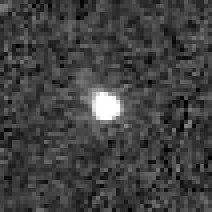 Hubble Space Telescope image of 1999 KR16 taken in 2010 | |
| Discovery [1] | |
|---|---|
| Discovered by | A. Dalsanti O. R. Hainaut |
| Discovery site | La Silla Obs. |
| Discovery date | 16 May 1999 |
| Designations | |
| (40314) 1999 KR16 | |
| 1999 KR16 | |
| TNO [2] ·other [3] · distant [1] | |
| Orbital characteristics [2] | |
| Epoch 23 March 2018 (JD 2458200.5) | |
| Uncertainty parameter 2 | |
| Observation arc | 16.09 yr (5,878 d) |
| Aphelion | 64.604 AU |
| Perihelion | 33.968 AU |
| 49.286 AU | |
| Eccentricity | 0.3108 |
| 346.02 yr (126,383 d) | |
| 347.77° | |
| 0° 0m 10.08s / day | |
| Inclination | 24.771° |
| 205.57° | |
| ≈ 26 February 2030 [4] | |
| 58.419° | |
| Physical characteristics | |
| 254±37 km [5] 255 km(est.) [6] | |
| 5.8 h (half period?) [7] 11.7 h [8] | |
| 0.204±0.070 [5] | |
| RR (very red) [9] | |
| 5.5 [1] [2] 5.527±0.039(R) [10] 5.7 [2] 5.59±0.02(R) [11] | |
(40314) 1999 KR16 is a trans-Neptunian object on an eccentric orbit in the outermost region of the Solar System, approximately 254 kilometers (158 miles) in diameter. It was discovered on 16 May 1999, by French astronomer Audrey Delsanti and Oliver Hainaut at ESO 's La Silla Observatory in northern Chile. [1] The very reddish object has a rotation period of 11.7 hours. [12]